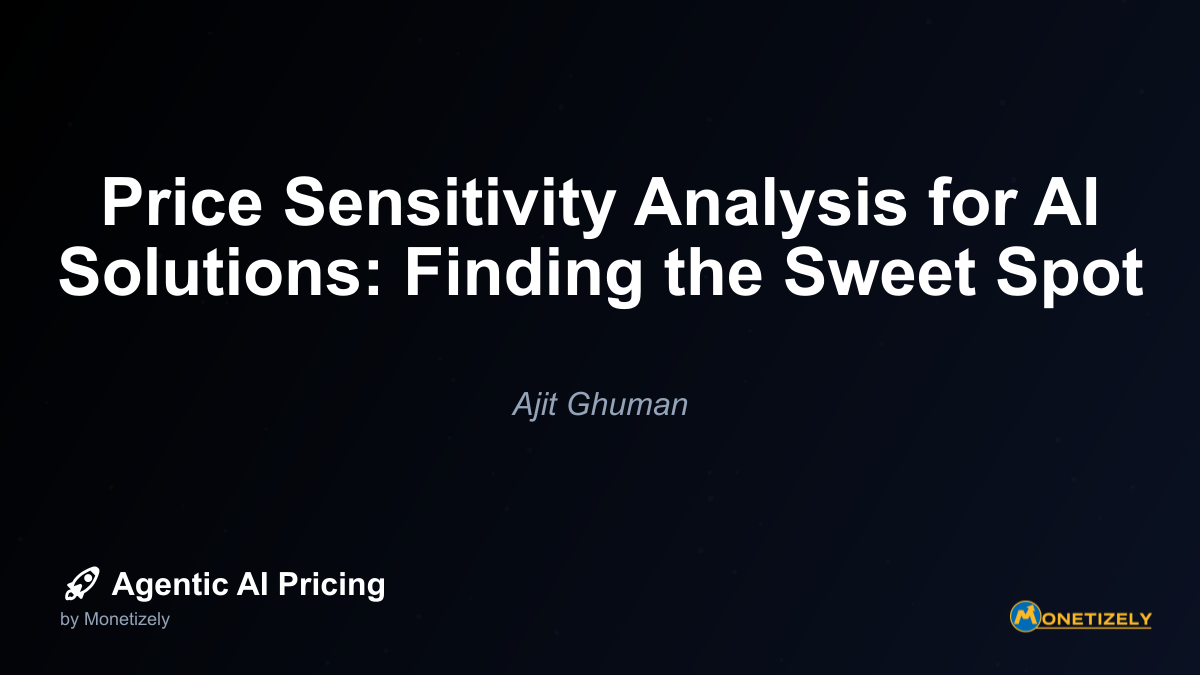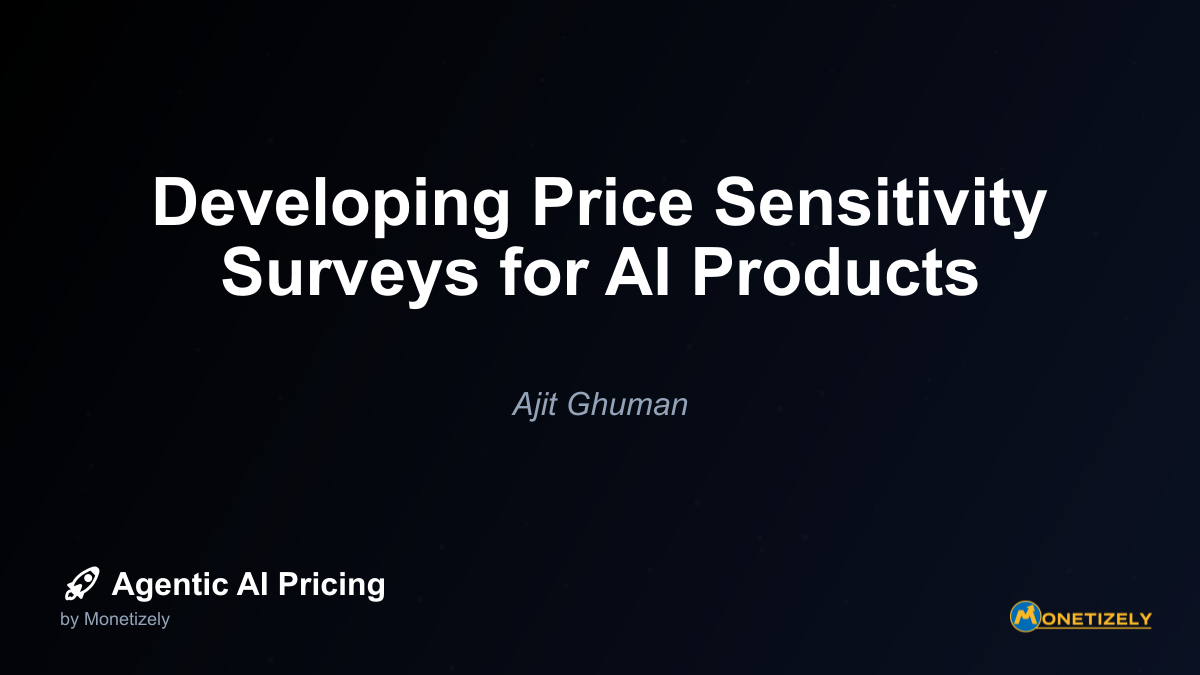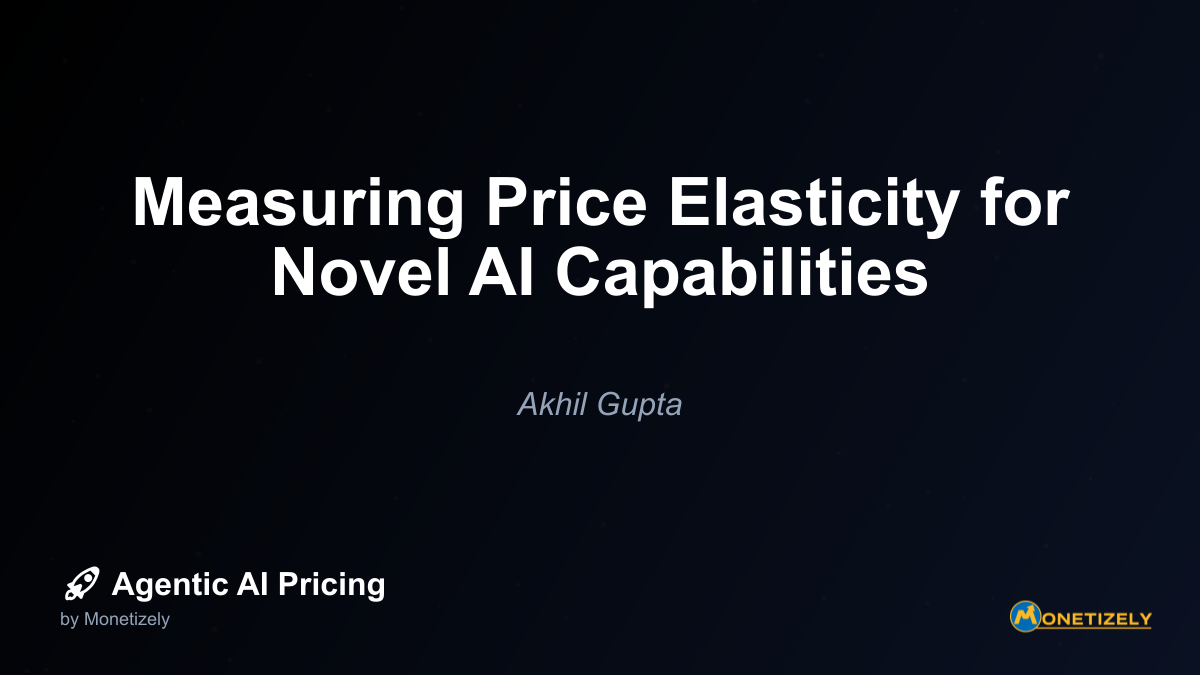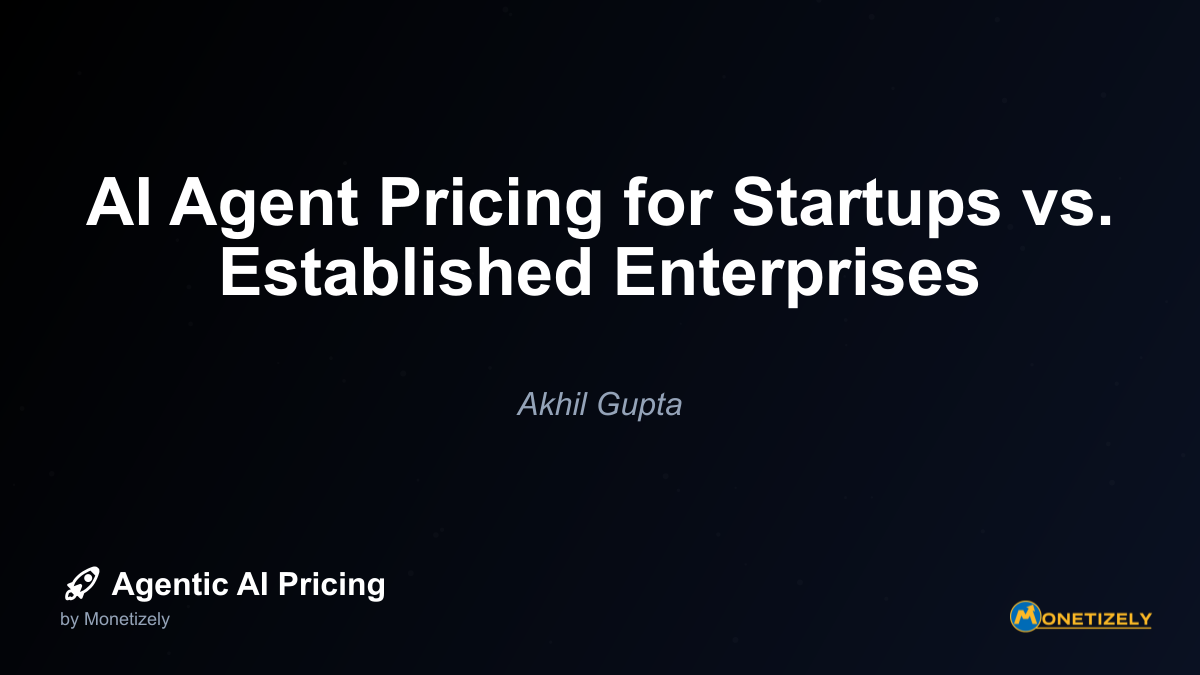· Ajit Ghuman · Strategy · 12 min read
Price Sensitivity Analysis for AI Solutions: Finding the Sweet Spot
AI and SaaS Pricing Masterclass
Learn the art of strategic pricing directly from industry experts. Our comprehensive course provides frameworks and methodologies for optimizing your pricing strategy in the evolving AI landscape. Earn a professional certification that can be imported directly to your LinkedIn profile.

In today’s rapidly evolving AI landscape, finding the optimal price point for your solution can mean the difference between market leadership and obscurity. As AI technologies become more sophisticated and widespread, organizations face the complex challenge of pricing these solutions in ways that balance profitability with market adoption. Price sensitivity analysis—the systematic examination of how customers respond to different price points—has emerged as a critical discipline for AI solution providers seeking to maximize revenue while driving adoption.
Understanding Price Sensitivity in the AI Context
Price sensitivity for AI solutions differs significantly from traditional software or services. The perceived value of AI is often tied to outcomes rather than features, creating unique pricing challenges and opportunities. According to recent market research, nearly 48% of enterprise buyers struggle to define clear, measurable outcomes from AI implementations, making value-based pricing particularly challenging.
Price sensitivity, or price elasticity of demand, measures how responsive customer demand is to changes in price. The mathematical representation is:
Price Elasticity = % Change in Demand / % Change in PriceFor AI solutions, this calculation takes on additional complexity due to several factors:
- Novelty and rapid evolution of AI technologies make historical pricing comparisons difficult
- Variable computing costs that fluctuate based on usage patterns
- Diverse value perception across different customer segments
- Competitive dynamics in a rapidly changing market landscape
Between late 2022 and late 2024, inference costs for models like GPT-3.5 fell by over 280-fold, while hardware costs decreased by approximately 30% annually. These rapid cost reductions create both opportunities and challenges for pricing strategies.
Key Methodologies for Testing Price Sensitivity
Van Westendorp Price Sensitivity Meter
The Van Westendorp Price Sensitivity Meter (PSM) is a survey-based approach that asks customers four key questions:
- At what price would you consider the AI solution to be so expensive that you would not consider buying it? (Too expensive)
- At what price would you consider the AI solution to be priced so low that you would question its quality? (Too cheap)
- At what price would you consider the AI solution to be getting expensive, but you would still consider buying it? (Expensive/High)
- At what price would you consider the AI solution to be a bargain—a great buy for the money? (Cheap/Good Value)
By plotting the cumulative distribution of responses, you can identify four critical price points:
- Point of Marginal Cheapness (PMC): The intersection of “too cheap” and “expensive”
- Point of Marginal Expensiveness (PME): The intersection of “too expensive” and “cheap”
- Optimal Price Point (OPP): The intersection of “too cheap” and “too expensive”
- Indifference Price Point (IPP): The intersection of “cheap” and “expensive”
The range between PMC and PME represents the acceptable price range, while OPP indicates a price point with minimal resistance.
For AI solutions, this methodology helps identify price thresholds where perceived value aligns with customer expectations. However, it’s important to segment responses by customer type, as enterprise customers often have significantly different thresholds than SMB or individual users.
Gabor-Granger Method
The Gabor-Granger method presents customers with a series of price points and asks about their likelihood to purchase at each price. Starting with a base price, the method incrementally increases or decreases the price based on customer responses.
The data collected allows for the creation of a demand curve that shows the relationship between price and purchase probability. The optimal price point is where revenue (price × probability × market size) is maximized.
This method is particularly effective for AI solutions with clearly defined feature sets or capabilities, as it allows for direct measurement of willingness-to-pay for specific AI functionalities.
Conjoint Analysis
Conjoint analysis is a more sophisticated approach that examines how customers value different product attributes, including price. Rather than asking about price directly, conjoint analysis presents customers with different product configurations (varying features, service levels, and prices) and asks them to rank or choose between alternatives.
Statistical analysis of these preferences reveals the relative importance of each attribute and customers’ willingness-to-pay for specific features or capabilities. This approach is especially valuable for AI solutions where different capabilities might have dramatically different values to customers.
For example, a conjoint analysis might reveal that customers are willing to pay a premium for AI that delivers specific business outcomes (like a 20% reduction in customer service costs) but are price-sensitive about features like customization options or integration capabilities.
Price Elasticity Testing
Direct price elasticity testing involves actual pricing experiments in the market. This can include:
- A/B testing: Offering different price points to similar customer segments and measuring conversion rates
- Regional testing: Testing different prices in comparable but separate markets
- Temporal testing: Changing prices over time and measuring demand changes
For AI solutions, these experiments must control for variables like feature differences, marketing support, and competitive dynamics. The data collected allows for direct calculation of price elasticity using the standard formula.
According to recent research, AI solutions demonstrate varying elasticity patterns:
- Enterprise AI solutions with clear ROI often show inelastic demand (elasticity < 1)
- Consumer-facing AI applications typically show elastic demand (elasticity > 1)
- Specialized AI for niche applications can show highly inelastic demand regardless of customer segment
Machine Learning and Regression Models
Advanced price sensitivity analysis for AI solutions increasingly leverages AI itself, with several approaches gaining prominence:
- Random Forests: Effective for short-term price sensitivity predictions with around 12+ months of transactional data
- Gradient Boosting: Captures seasonal trends and complex nonlinearities with 18+ months of data
- Neural Networks: Provides long-term demand and price optimization using 24+ months of detailed data
- Optimal Decision Trees: Maintains transparency while accurately modeling elasticity, helping business users trust and implement insights
These models can process large volumes of transaction data, account for numerous variables, and identify complex patterns that might not be apparent through traditional methods.
Data Collection for Price Sensitivity Analysis
Effective price sensitivity analysis depends on comprehensive data collection. For AI solutions, this should include:
Historical Sales and Pricing Data
- Transaction records with price points, volumes, and dates
- Discount and promotion history
- Conversion rates at different price points
- Customer acquisition costs by segment and channel
Customer Segmentation Data
- Industry/vertical
- Company size
- Use case and application
- Geographic region
- Buyer persona and role
Competitive Intelligence
- Competitor pricing models and strategies
- Market share data
- Substitute product pricing
- Industry pricing benchmarks
The global generative AI solutions market, valued at $18.6 billion in 2024, is expected to grow at a CAGR of 25-26% through 2034. This rapid growth creates both opportunities and challenges for pricing strategies, making competitive intelligence particularly important.
Usage and Behavioral Data
- Feature utilization patterns
- Computing resource consumption
- API call volumes
- User engagement metrics
- Value realization indicators
For AI solutions with usage-based components, understanding how different customer segments use the product is essential for predicting price sensitivity and designing appropriate pricing models.
Implementation Challenges for AI Price Sensitivity Analysis
Complexity in Quantifying Value
Unlike traditional software, AI solutions often deliver value in ways that are difficult to quantify directly. This can include improved decision-making, risk reduction, or creative output enhancement. Without clear value metrics, customers may struggle to evaluate price-to-value relationships.
To address this challenge:
- Develop proxy metrics that correlate with value delivery
- Create case studies and ROI calculators specific to customer segments
- Implement value-based pricing only for outcomes that can be clearly measured
- Use tiered pricing to accommodate different value perceptions
Rapid Evolution of AI Capabilities
The fast pace of AI advancement means that capabilities, costs, and competitive offerings change rapidly. Historical price sensitivity data may quickly become obsolete as the market evolves.
To address this challenge:
- Conduct price sensitivity analysis more frequently (quarterly rather than annually)
- Build flexibility into pricing models to accommodate evolving capabilities
- Use modular pricing components that can be adjusted independently
- Develop scenario-based pricing models that anticipate technology changes
Data Scarcity and Variability
For newer AI offerings, limited sales history or diverse customer use cases can introduce uncertainty in elasticity measurement. This is particularly challenging for breakthrough innovations without clear market precedents.
To address this challenge:
- Combine multiple methodologies (surveys, experiments, and competitive analysis)
- Start with controlled experiments in limited market segments
- Use analogous products or services as reference points
- Implement continuous learning approaches that refine pricing as data accumulates
Non-Linear Price Sensitivity
Price sensitivity for AI solutions often exhibits non-linear patterns, with dramatic shifts at certain thresholds. For example, enterprise customers may be relatively insensitive to price differences between $50,000 and $60,000 but highly sensitive to crossing the $100,000 threshold due to procurement policies.
To address this challenge:
- Test price points around suspected threshold boundaries
- Segment analysis by customer size and type
- Consider psychological pricing factors in addition to economic ones
- Use advanced statistical methods that can capture non-linear relationships
Designing Effective Price Sensitivity Research
Segmentation Strategies
Price sensitivity varies dramatically across customer segments. Effective research design requires thoughtful segmentation:
By Customer Size:
- Enterprise (1000+ employees)
- Mid-market (100-999 employees)
- SMB (10-99 employees)
- Micro-business/Individual (1-9 employees)
By Industry Vertical:
- Financial services
- Healthcare
- Retail
- Manufacturing
- Technology
- Professional services
By Use Case:
- Customer service automation
- Content creation and optimization
- Data analysis and insights
- Process automation
- Decision support
- Creative applications
Each segment may have different value drivers, budget constraints, and alternative solutions, resulting in significantly different price sensitivity profiles.
Survey Design Best Practices
When using survey-based methodologies like Van Westendorp or Gabor-Granger, consider these best practices:
Provide clear context: Ensure respondents understand exactly what the AI solution does and the value it delivers before asking price questions
Use realistic scenarios: Frame questions around specific use cases rather than abstract capabilities
Incorporate competitive reference points: Include information about alternative solutions to establish a realistic context
Minimize bias: Randomize price points and question order to prevent anchoring effects
Qualify respondents: Ensure survey participants are actual decision-makers or influencers for AI purchases
Include qualitative components: Add open-ended questions about value perception and price considerations
For example, instead of asking “How much would you pay for an AI content generator?”, a better approach would be: “Imagine your marketing team needs to create 100 personalized email campaigns monthly. If an AI solution could reduce this work from 40 hours to 5 hours while maintaining quality, at what price point would you consider it…”
Experimental Design Considerations
When conducting direct pricing experiments:
Ensure statistical validity: Calculate required sample sizes for each test segment
Control for external variables: Account for seasonal effects, marketing activities, and competitive changes
Test incrementally: Use small price changes (5-10%) to avoid market disruption
Measure multiple outcomes: Track not just conversion rates but also customer quality, usage patterns, and retention
Consider ethical implications: Be transparent with customers about pricing tests and avoid discriminatory practices
Analyzing and Interpreting Price Sensitivity Data
Understanding Elasticity Coefficients
Price elasticity coefficients provide quantitative measures of sensitivity:
- Elastic demand (|E| > 1): Percentage change in quantity exceeds percentage change in price
- Inelastic demand (|E| < 1): Percentage change in quantity is less than percentage change in price
- Unit elastic demand (|E| = 1): Percentage changes are equal
For AI solutions, interpretation must consider:
- Segment-specific elasticity: Different customer segments often show dramatically different elasticity coefficients
- Price range effects: Elasticity may vary at different points along the price spectrum
- Time horizon: Short-term elasticity often differs from long-term elasticity as markets adjust
Revenue Optimization Analysis
Price sensitivity data enables revenue optimization analysis:
Revenue impact modeling: Calculate how different price points affect total revenue
Profit optimization: Incorporate cost structures to identify profit-maximizing price points
Market share scenarios: Model how different pricing strategies affect market penetration
Competitive response analysis: Consider how competitors might react to your pricing changes
For AI solutions with high fixed costs and low marginal costs, pricing strategies often focus on maximizing adoption to achieve economies of scale while maintaining sustainable margins.
Willingness-to-Pay Distribution Analysis
Beyond average elasticity, analyzing the distribution of willingness-to-pay provides valuable insights:
Identify price thresholds: Points where significant portions of the market enter or exit
Recognize segment differences: How willingness-to-pay varies across customer groups
Inform tiered pricing: Design tier boundaries that align with natural breaks in willingness-to-pay
Target high-value segments: Identify customer groups with higher willingness-to-pay for focused marketing
For example, analysis might reveal three distinct willingness-to-pay clusters among enterprise customers, suggesting a three-tier enterprise pricing strategy.
Pricing Model Selection Based on Sensitivity Analysis
Subscription-Based Pricing
Subscription models provide predictable recurring revenue and are well-suited for AI solutions with:
- Inelastic demand: Where customers value ongoing access and are less price-sensitive
- Regular usage patterns: Where value is delivered consistently over time
- Continuous improvement: Where AI capabilities evolve and improve with use
Price sensitivity analysis can inform subscription pricing by:
- Determining optimal price points for different tiers
- Identifying feature bundles that maximize willingness-to-pay
- Setting appropriate term discounts (annual vs. monthly)
According to recent research, subscription models have shown strong results for enterprise AI solutions, with companies using AI to reduce pricing-related churn by up to 17% through early detection and retention pricing strategies.
Usage-Based Pricing
Usage-based pricing aligns costs with actual consumption and works well for AI solutions with:
- Variable usage patterns: Where consumption fluctuates significantly across customers
- Elastic demand: Where lower entry barriers drive adoption
- Measurable usage units: Where consumption can be tracked (API calls, compute time, etc.)
Price sensitivity analysis informs usage-based pricing by:
- Setting optimal rates for different usage metrics
- Designing volume discount structures
- Determining minimum commitments and overage rates
Companies like Zoom have leveraged AI-powered usage analytics to optimize pricing tiers, improving average revenue per user by 23%.
Outcome-Based Pricing
Outcome-based pricing ties fees to delivered results and is suitable for AI solutions with:
- Clearly measurable outcomes: Where success metrics are definable and trackable
- High-value results: Where outcomes deliver significant ROI
- Differentiated performance: Where your AI outperforms alternatives
Price sensitivity analysis supports outcome-based pricing by:
- Quantifying customer value from outcomes
- Determining fair value-sharing ratios
- Setting appropriate risk-reward parameters
While less common due to implementation complexity, outcome-based pricing can be particularly effective for AI agents that deliver specific, measurable results like customer service resolutions or sales conversions.
Hybrid Pricing Models
Many successful AI pricing strategies combine elements of multiple models:
- Base subscription + usage components: Providing predictability with alignment to consumption
- Tiered access + outcome guarantees: Offering value assurance at premium tiers
- Consumption-based pricing with caps: Limiting customer risk while capturing upside
Price sensitivity analysis is essential for hybrid models, helping determine the optimal balance between components and identifying which elements drive the most value for different segments.
Implementing Insights from Price Sensitivity Analysis
Pricing Strategy Development
Translating price sensitivity insights into strategy requires:
Segment-specific approaches: Tailoring pricing to different customer segments based on their unique sensitivity profiles
Competitive positioning: Determining whether to price at premium, parity, or discount relative to alternatives
Value communication: Developing messaging that justifies pricing based on delivered value
Adoption acceleration: Using strategic pricing to drive market penetration
Effective AI pricing strategies often include:
- Premium pricing for high-value, specialized capabilities
- Penetration pricing for platform components that benefit from network effects
- Value-based pricing for clearly measurable outcomes
- Competitive pricing for commoditized features
Tiered Pricing Optimization
Price sensitivity analysis directly informs tiered pricing design:
Tier boundary optimization: Setting tier limits at natural breakpoints in willingness-to-pay
Feature allocation: Determining which capabilities belong in which tiers
Upsell pathway design: Creating clear value progression across tiers
Segment alignment: Ensuring tiers map to distinct customer segments
For AI solutions, effective tier design often includes:
- Basic tiers with limited but valuable AI capabilities
- Professional tiers with expanded AI functionality and integration options
- Enterprise tiers with customization, advanced analytics, and dedicated support
- Industry-specific tiers tailored to vertical-specific AI applications
Price Testing and Iteration
Price sensitivity is not static, particularly in the rapidly evolving AI market. Ongoing testing and refinement are essential:
Continuous monitoring: Tracking conversion rates, customer acquisition costs, and retention at current price points
**Controlle
Co-Founder & CEO
Ajit is the author of Price To Scale, a top book on SaaS Pricing and is the Founder of Monetizely. Ajit has led and worked in pricing and product marketing at firms like Twilio, Narvar and Medallia. His work has been featured in Forbes and VentureBeat. Ajit regularly consults with software companies from Seed stage to post-IPO on pricing strategy. Ajit is also a highly-rated co-instructor for 'The Art of SaaS Pricing and Monetization' on Maven.
Pricing Strategy Audit
Let our experts analyze your current pricing strategy and identify opportunities for improvement. Our data-driven assessment will help you unlock untapped revenue potential and optimize your AI pricing approach.




